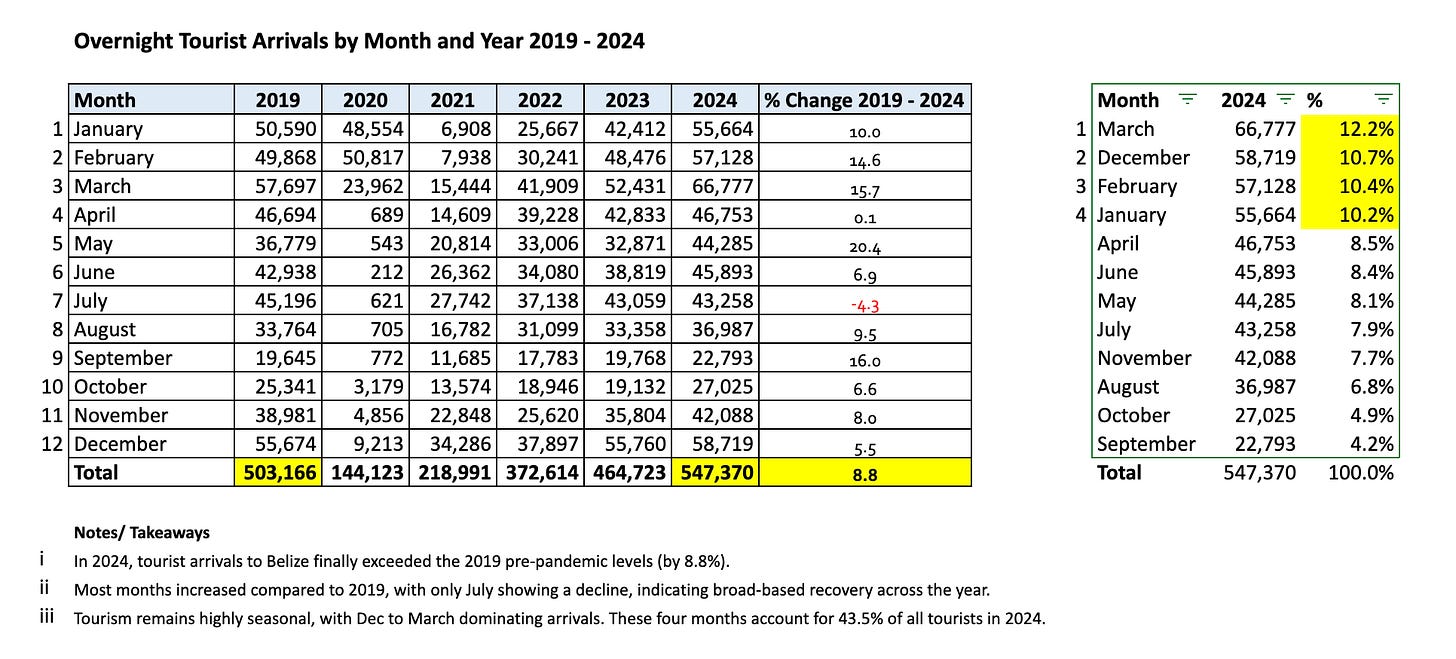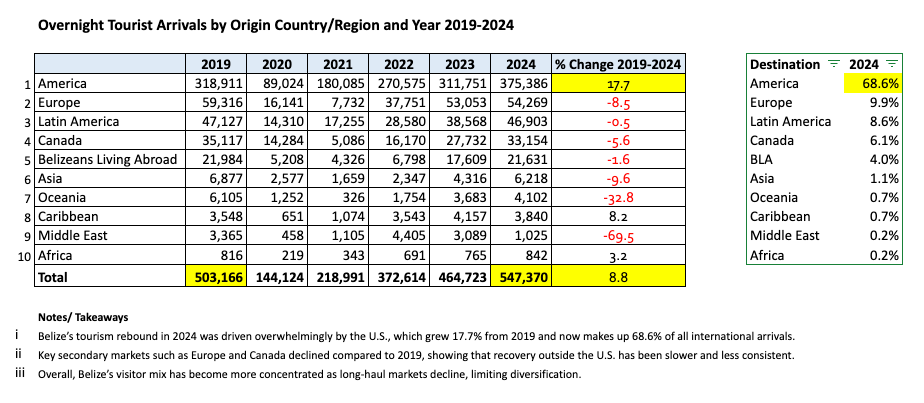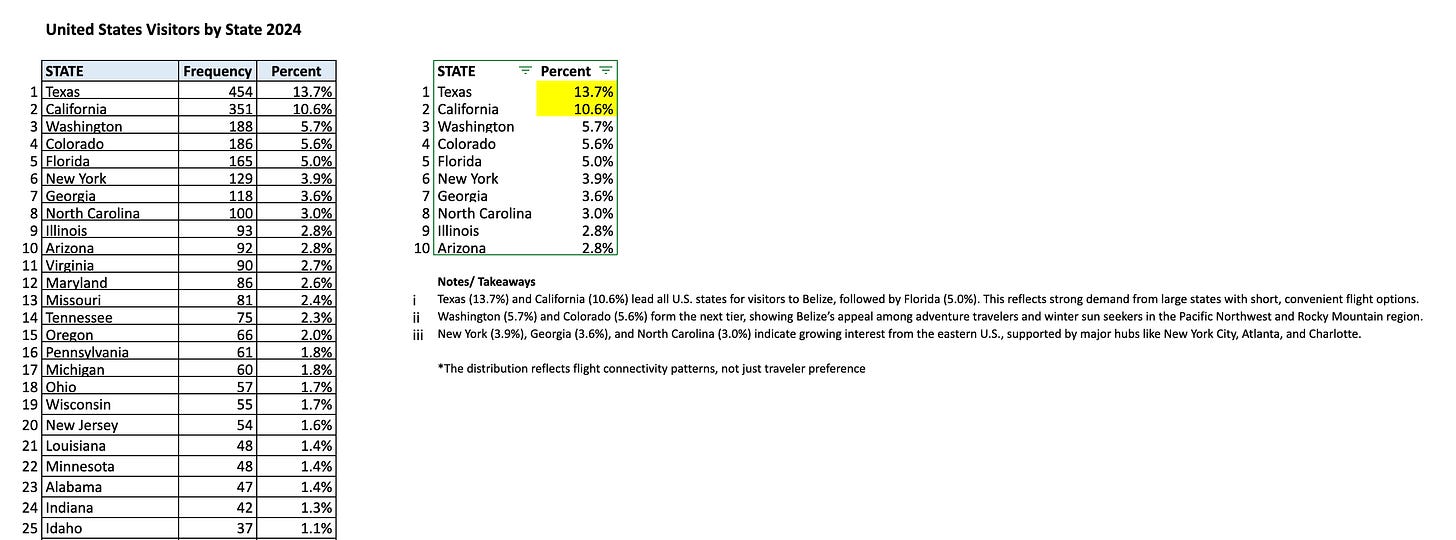Belize Visitor Trends and Practical Takeaways
Five essential charts that reveal clear opportunities for improving experiences, planning, and strategy across the Belize tourism industry.
Following up from my earlier post on how visitors first hear about Belize, I took a closer look at a few more charts from the Belize Tourism Board’s Travel & Tourism Statistics Digest 2024. I focused on datasets that show who is visiting, when they travel, and where they choose to stay, and I thought it would be helpful to share those insights here.
For anyone working in Belize’s tourism sector — hotels, tour operators, restaurants, or marketers — these trends aren’t just interesting. They’re practical. They show which audiences to prioritize, where gaps remain, and which opportunities are often overlooked without data. And while it’s great that the BTB collects and shares this information, they should also consider presenting what the data means to stakeholders, similar to what I’ll do below.
1. Seasonality: When Visitors Come
Belize’s annual tourism cycle remains highly seasonal, following a monthly rhythm that is broadly similar to the pre-pandemic years.
Highlights
2024 tourism finally surpassed 2019 levels, up 8.8% overall.
Most months increased relative to 2019, with only July declining.
December to March dominates, making up 43.5% of all arrivals.
What this means for you
Start your high-season marketing in September and October to get in front of early planners and build momentum heading into the December-March peak.
Use promotions and programming to stabilize demand during the quietest stretch from August to October, when interest is lowest and travelers need extra reasons to book.
Plan staffing, inventory, and budgeting around a predictable high season.
2. Where Visitors Come From
Belize’s visitor mix has shifted.
Highlights
The United States now makes up 68.6% of all arrivals, growing 17.7% since 2019.
Europe and Canada have declined compared to pre-pandemic levels.
Belize’s visitor base is more concentrated than before, with fewer travelers from long-haul regions.
What this means for you
Focus most of your marketing on the United States, since Americans now make up 68.6% of visitors and continue to show the strongest growth.
Treat Europe and Canada as secondary but valuable niche markets, using targeted storytelling about culture, nature, and longer-stay travel that appeals to these regions.
Build strategies with a more concentrated visitor mix in mind, knowing that long-haul markets remain small and recovery outside the U.S. is uneven.
3. U.S. States: Where Americans Come From
If nearly seven out of ten tourists are American, it helps to know which Americans.
Highlights
Texas (13.7%) and California (10.6%) lead all U.S. states.
Washington (5.7%) and Colorado (5.6%) reflect strong adventure and outdoor travel markets.
New York, Georgia, and North Carolina show rising East Coast interest.
What this means for you
Prioritize geo-targeted marketing in Texas and California, since these two states alone represent almost a quarter of all U.S. visitors to Belize.
Use direct-flight messaging when targeting Washington, Colorado, Florida, New York, Georgia, and North Carolina, where major hubs make trip planning easier.
Tailor content to state-specific travel motivations, such as quick winter escapes for Texas and Florida or adventure-focused itineraries for Colorado and Washington.
4. Who Visits: Age and Gender Trends
Belize’s visitor demographics reveal an important pattern.
Highlights
60.9% of all visitors are between ages 35-64.
Men cluster in the 45-54 range. Women skew younger, with 25-34 being their largest group.
Very few visitors are under 18.
What this means for you
Position Belize as a destination for mid-career and mature adults, since three out of five visitors fall between ages 35 and 64.
Create differentiated messaging for men and women, with comfort- and adventure-focused content for older male travelers, and social, wellness, culture, and experience-focused content for younger women.
Recognize that family travel is a smaller segment, so any family-focused product or accommodation must highlight child-friendly features more clearly to grow awareness and aim to dominate this small market.
5. Where Visitors Stay: The Destination Breakdown
This chart shows how uneven Belize’s visitor distribution actually is.
Highlights
San Pedro dominates, with 43.1% of all visitors staying there. Americans are especially concentrated in San Pedro.
Caye Caulker skews heavily European, with the highest U.K./Europe share in the entire dataset.
Inland destinations attract far fewer visitors.
What this means for you
San Pedro and Caye Caulker should keep tailoring their messaging and products to their core audiences, but they can also test targeted efforts to attract the other’s market for simple diversification.
Even without heavy promotion, many travelers stay in Belize City because of its convenience for flights and transfers. It’s a practical entry point and businesses should consider how to capture or better serve visitors during this short stay.
Inland destinations must counteract the strong pull of the cayes by positioning themselves as the signature experiences that travelers can’t leave Belize without seeing, shifting the mainland from an optional add-on to an expected part of every trip.
Putting It All Together
Across all of these charts, the story is consistent:
Belize’s tourism fully recovered in 2024, with strong and predictable seasonality centred on December to March. This provides a reliable window for planning but highlights the need to build stronger marketing and products that lift demand in the quieter months.
The U.S. market is more important than ever, driving most of the country’s growth. This is good for business since Americans spend more but it’s bad for market diversification.
Belize should look for ways to diversify its visitor base, since relying heavily on one market leaves the industry very vulnerable to external shocks.
Visitors skew older, so mid-career adults remain the core market. Younger women are a growing niche, and better safety and women-friendly experiences can help attract them.
Travelers overwhelmingly choose the islands, a trend that will hold unless the mainland offers a strong alternative, which is key to balancing visitor distribution over time.






